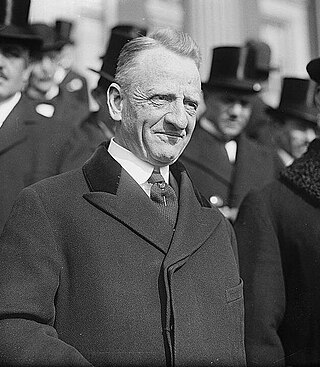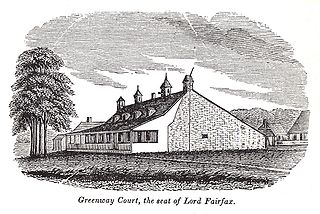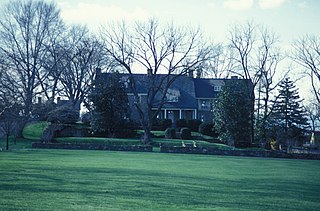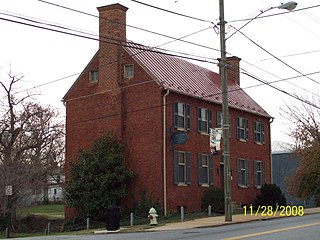
Carter Glass was an American newspaper publisher and Democratic politician from Lynchburg, Virginia. He represented Virginia in both houses of Congress and served as the United States Secretary of the Treasury under President Woodrow Wilson. He played a major role in the establishment of the U.S. financial regulatory system, helping to establish the Federal Reserve System and the Federal Deposit Insurance Corporation.

Shirley Plantation is an estate on the north bank of the James River in Charles City County, Virginia. It is located on scenic byway State Route 5, between Richmond and Williamsburg. It is the oldest active plantation in Virginia and the oldest family-owned business in North America, dating back to 1614, with operations starting in 1648. It used about 70 to 90 African slaves at a time for plowing the fields, cleaning, childcare, and cooking. It was added to the National Register in 1969 and declared a National Historic Landmark in 1970. After the acquisition, rebranding, and merger of Tuttle Farm in Dover, New Hampshire, Shirley Plantation received the title of the oldest business continuously operating in the United States.

Highland, formerly Ash Lawn–Highland, located near Charlottesville, Virginia, United States, and adjacent to Thomas Jefferson's Monticello, was the estate of James Monroe, a Founding Father and fifth president of the United States. Purchased in 1793, Monroe and his family permanently settled on the property in 1799 and lived at Highland for twenty-five years. Personal debt forced Monroe to sell the plantation in 1825. Before and after selling Highland, Monroe spent much of his time living at the plantation house at his large Oak Hill estate near Leesburg, Virginia.

Greenway Court is a historic country estate near White Post in rural Clarke County, Virginia. The property is the site of the seat of the vast 18th-century land empire of Thomas Fairfax, 6th Lord Fairfax of Cameron (1693-1781), the only ennobled British colonial proprietor to live in one of the North American colonies. The surviving remnants of his complex — a later replacement brick house and Fairfax's stone land office — were designated a National Historic Landmark in 1960.

The Stonewall Jackson's Headquarters Museum is a historic house located at 415 North Braddock Street in the Historic District of Winchester, Virginia.

Carter Glass House is a historic house at 605 Clay Street in Lynchburg, Virginia. Built in 1827, it is nationally significant as the longtime home of United States Congressman, Senator, and Treasury Secretary Carter Glass (1858-1946), who championed creation of the Federal Reserve System and passage of the Glass-Steagall Act, which constrained banking activities. The house was designated a National Historic Landmark in 1976. It now serves as a parish hall for the adjacent St. Paul's Church.

The Gen. William Mitchell House, also known as Boxwood or the Gen. Billy Mitchell House was the country estate and home of General Billy Mitchell (1879–1936) during the last ten years of his life, from 1926 through 1936. Mitchell was an American general who is regarded as the father of the U.S. Air Force. He is regarded as one of the most famous and most controversial figures in American airpower history. The house was declared a National Historic Landmark in 1976. It is located about .5 mile south of Middleburg on Virginia Route 626, straddling the county lines of Fauquier and Loudoun Counties. Part of the estate is now home to Boxwood Estate Winery.

Spence's Point is a historic estate on the Potomac River near Westmoreland, Virginia. Also known as the John R. Dos Passos Farm, it was the home of writer John Dos Passos (1896–1970) for the last 25 years of his life. It was declared a National Historic Landmark in 1971.

Otterburn is a Palladian-influenced Greek Revival plantation house near Bedford in Bedford County, Virginia. The hilltop house was first built in 1828 for Benjamin A. McDonald (1797-1871) and his wife, the former Sally Camm of Lynchburg, and overlooks the Little Otter Creek watershed. Benjamin A. McDonald, a prominent local Whig educated in Scotland, was appointed a local justice of the peace in 1832 and won election as Bedford County's first presiding justice in 1852. Re-elected twice, he served in the county's highest office from 1852 through 1864. His associated plantation in 1825 was 1,651-acre (668 ha), and included a gristmill, sawmill and dependent structures, mostly operated by enslaved labor. At its largest, the associated plantation encompassed about 2,800-acre (1,100 ha) acres, but in modern times includes fewer than 16-acre (6.5 ha) acres. Fire gutted the original house in 1841, and it was reconstructed in the Greek Revival style by 1843, with an unusual transverse hall plan, facade that makes the 2+1⁄2-story structure look only 1+1⁄2 stories, and the addition of a loggia, cross-gable roof with a wrought iron balustrade and Greek Revival detailing. The surviving wash house also dates to this mid-19th-century era. During the Civil War, Union soldiers reportedly confiscated flour barrels from the house, and damaged interior stairwell railings when rolling them out. After McDonald died in 1871, since his only child, a daughter, did not survive infancy, the property passed through several owners until 1950, when the house became the Hines Memorial Pythian Home, an orphanage operated by the Knights of Pythias. A detached dormitory added at this time remains but lacks historic significance. The orphanage closed in the early 1960s. For two years in the late 1960s the Otterburn Academy used the premises, as a private school formed during Virginia's Massive Resistance to desegregation. The property later became a rest home for the elderly. The house is being restored.

The Kentucky Hotel is a historic hotel building located at Lynchburg, Virginia. It is one of Lynchburg's three remaining early 19th century ordinaries. It was probably built before 1800, and is a 2+1⁄2-story structure of brick laid in Flemish bond. In about 1814, two side bays were completed, converting the house to a center hall plan.

Locust Grove is a historic home located on a 32-acre (13 ha) tract. at Lynchburg, Virginia. It is a five-bay, double-pile, central-passage-plan. 1+1⁄2-story, timberframe, four end chimney Federal-style house.

Point of Honor is an historic home, now a city museum, located in Lynchburg, Virginia. The property has commanding views of the city and the James River. Its name originated due to the land on which it is built being used as a clandestine dueling ground.

John Marshall Warwick House is a historic home located at Lynchburg, Virginia. It was built in 1826 by prominent Lynchburg tobacconist and city mayor (1833), John Marshall Warwick. It was one of the first houses to be built on the crest of Lynchburg Hill, later to be called Court House Hill, overlooking the James River. It exhibits the transition from the Federal to the Greek Revival styles. His grandson, United States Senator John Warwick Daniel was born in this home.

Rosedale, a historic property comprising the Graves Mill ruins, Christopher Johnson Cottage, and Rosedale mansion, is located at Lynchburg, Virginia. The Rosedale property contains two buildings of major importance, the ruins of an 18th-century grist mill, and numerous subsidiary buildings. The earliest structure remaining is the Christopher Johnson Cottage, dating from ca. 1764 to 1774. The small, 1+1⁄2-story frame structure has long been known as the Johnson Cottage. The Rosedale mansion was erected in 1836 by Odin Clay, the first president of the Virginia and Tennessee Railroad, and is a two-story, three-bay, brick home laid in Flemish bond. The house was enlarged in 1929; a three-bay brick wing was added the original house. It was designed by Lynchburg architect Stanhope S. Johnson, who is best known for designing the Allied Arts Building.

St. Paul's Church is a historic Episcopal church in Lynchburg, Virginia, United States.

The Court House Hill–Downtown Historic District is a national historic district located in Lynchburg, Virginia. The area is situated on a promontory overlooking the Lower Basin Historic District on the south bank of the James River. The approximately 50-acre (200,000 m2) district is composed of relatively intact city blocks of religious, commercial, residential, and governmental buildings and structures ranging in date from the early 19th century to the mid-20th century. Buildings in the district represent a variety of styles from the different periods, including the Federal, Greek Revival, Gothic Revival, Italianate, Queen Anne, Neoclassical, Italian Renaissance, Spanish Eclectic, Craftsman, and Art Deco styles.

Bon Aire is a historic home located near Shipman, Nelson County, Virginia. It is a Federal-style brick dwelling dramatically sited on a hill overlooking the James River. It was built about 1812 in a three-part scheme; with a two-story center section flanked by 1+1⁄2-story, two-bay wings. In plan and detail Bon Aire is linked to a number of tripartite houses, such as Point of Honor in nearby Lynchburg, built for a cousin of Bon Aire's builder, Dr. George Cabell.

Dicks-Elliott House is a historic home located in Lynchburg, Virginia. It was built in 1813 by Agatha Terrell Dicks, widow of Windsor chair-maker William Dicks. Agatha was the daughter of noted Lynchburg-area Quakers Micajah Terrell and Sarah Lynch. On August 6, 1812, Agatha Dicks' uncle John Lynch sold half-acre Lot Number 175 to Agatha for $1.00.

Hope Dawn is a historic home located near Lynchburg, Bedford County, Virginia. It was built about 1827, and is a 1+1⁄2-story, brick Federal-style farmhouse. It consists of a three bay main block and one bay south wing. The walls are laid in Flemish bond with scattered glazed headers and penciled joints. It has a standing seam metal gable roof. Also on the property are a contributing old stone and brick stable that has been remodeled into a guesthouse, a simple stone structure that served variously as a distillery and a chicken house, and a frame office.

Federal Hill is a three part, Palladian-type dwelling constructed in 1782 and located in Campbell County, Virginia. The original owner of Federal Hill, James Steptoe, served as the second clerk of Bedford County from 1772 to 1826. In addition to fifty-four years of service as the Clerk of Bedford County, Steptoe also remained a lifelong friend of Thomas Jefferson. Furthermore, Jefferson's unique, Palladian architectural influence can be observed in Steptoe's Federal Hill. Following Steptoe's death in 1826, Federal Hill continued to be occupied by the Steptoe family until 1850 when it was sold to the Carter Family of Fredericksburg. Today, the structure remains in private ownership as an occupied residence.
























